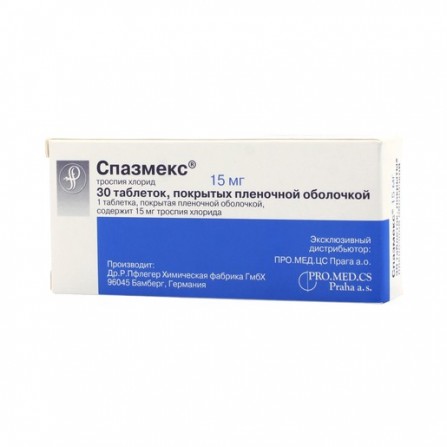Spasmex pills coated 15mg N30
Condition: New product
1000 Items
Rating:
Be the first to write a review!

More info
Active ingredients
Trospium chloride
Release form
Pills
Composition
Each coated tablet contains 15 mg or 30. mg of trospium chloride. Auxiliary substances - lactose monohydrate, microcrystalline cellulose, sodium starch glycolate, corn starch, stearic acid, povidone (K 25), colloidal silicon dioxide, hypromellose, titanium dioxide.
Pharmacological effect
Trospium chloride, a quaternary ammonium base, belongs to the group of anticholinergics. It is a competitive acetylcholine antagonist on smooth muscle postsynaptic membrane receptor receptors. It has a high affinity for M1 - and M3 - cholinergic receptors. Reduces the increased activity of the bladder detrusor. Trospia chloride has some ganglioblokiruyuschee action, as well as myotropic action, like papaverine. It does not have central effects.
Pharmacokinetics
The maximum concentration in blood plasma (Сmax) is reached in 4-6 after oral administration of trospia chloride. The half-life of T1 / 2 after oral administration is on average 5-18 hours, does not accumulate. Binding to plasma proteins is 50-80%. The concentration of trospium chloride in a single dose of 20 to 60 mg is proportional to the dose taken. Excreted by the kidneys, the majority - in unchanged form, about 10% - in the form of spiroalkol, a metabolite formed during the hydrolysis of ester bonds.
Indications
urinary incontinence and urge to urinate (with idiopathic detrusor hyperactivity; with neurogenic hyperactivity (hyperreflexia) of the detrusor - multiple sclerosis, spinal injuries, congenital and acquired spinal cord diseases, strokes, parkinsonism, etc.); detrusor-sphincter-dysynergia on the background of intermittent catheterism; in the treatment of cystitis, accompanied by imperative symptoms; pollakiuria, nocturia; night and daytime enuresis; mixed forms of urinary incontinence.
Contraindications
hypersensitivity to the drug, drug components; urine retention; narrow-angle glaucoma; tachyarrhythmia; myasthenia gravis; age up to 14 years (adequate strictly controlled studies of the use of trospia chloride in children were not conducted).
Use during pregnancy and lactation
The use of trospia chloride during pregnancy and lactation is possible only when the expected benefit to the mother outweighs the potential risk for the fetus and child (there are no adequate, well-controlled studies of the use of trospia chloride in pregnant women and during breastfeeding).
Dosage and administration
Tablets are taken before meals, without chewing and drinking plenty of water. For adults and children from 14 years of age, trospia chloride is prescribed individually, depending on the clinical picture and the severity of the disease. Is taken orally on 10 mg 3 times a day (30 mg / day) or 15 mg 2-3 times a day (30-45 mg / day). With a daily dose of 45 mg, it is also permissible to take 30 mg in the morning and 15 mg in the evening. When neurogenic hyperactivity of the detrusor trospia chloride is prescribed, 15-20 mg 2 times a day in the morning and evening (30-40 mg / day). On average, the duration of treatment is 2-3 months. After symptoms disappear, anti-relapse treatment is recommended for 2-4 weeks. If you need a longer treatment, the question of continuing treatment is reviewed by a doctor every 3-6 months. In patients with renal insufficiency (creatinine clearance 10-30 ml / min / 1.73 m2), the daily dose of trospium chloride should not exceed 20 mg.
Side effects
The frequency of occurrence of side effects (number of cases: number of observations) - frequent: more than 1: 100; infrequent: 1: 100-1000; rare: less than 1: 1000 .; Since the cardiovascular system: rare - tachycardia .; On the part of the digestive tract: frequent - dry mouth, dyspepsia, constipation, nausea .; From the side of the central nervous system: infrequent - accommodation paresis .; On the part of the urinary system: infrequent - a violation of the emptying of the bladder .; Allergic reactions: infrequent - skin rash.
Overdose
Signs of overdose are increased anticholinergic symptoms, such as blurred vision, tachycardia, dry mouth and skin hyperemia. Treatment: gastric lavage and taking of adsorbents (activated carbon, etc.), local administration of pilocarpine in patients with glaucoma, catheterization during urinary retention. In severe cases, the appointment of cholinomimetics (for example, neostigmine). With insufficient effect, severe tachycardia and / or instability of blood circulation - the introduction of beta-blockers (for example, 1 mg of propranolol intravenously under the control of an ECG and blood pressure).
Interaction with other drugs
Enhances the action of amantadine, tricyclic antidepressants, quinidine, antihistamine drugs, disopyramide, beta-adrenostimulyatorov.
special instructions
Before starting treatment, it is necessary to exclude organic causes of pollakiuria and urinary incontinence, such as cardiac or renal failure, polydipsia, urinary tract tumors .; If the urethral sphincter function or detrusor is impaired, a full bladder emptying should be ensured by catheterization .; During the period of treatment, it is necessary to refrain from driving vehicles and practicing potentially hazardous activities that require increased concentration and psychomotor speed of reaction .; No interactions of trospium chloride with cytochrome P450 (P450) enzymes involved in the cleavage of drugs in the process of metabolism (P450 1A2, 2A6, CS9, 2C19, 2D6, 2E1, ZA4) were detected. Therefore, interactions with other drugs affecting the cytochrome system are not expected.




